Howard Frankland project advances; will accommodate future transit needs
The new $865 million Howard Frankland Bridge replacement that will connect Tampa and St. Petersburg is on track to open in late 2025, and it will have the capability to support future modes of transit.
Construction alongside the existing Howard Frankland, which was built in the 1960s, started in late 2020.
Drivers commuting by the existing bridge can see the progress as 170 contractors work day and night on barges, pouring concrete and operating cranes.
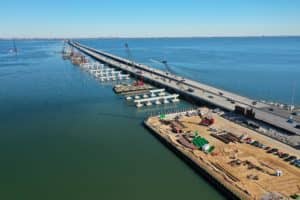
Construction photo of the new Howard Frankland Bridge alongside the existing bridge.
The new bridge will have eight lanes: four will be general use lanes, allowing drivers to travel from Tampa to St. Petersburg, and four will be express lanes.
The construction team for the bridge replacement is a joint venture between Atlanta-based contractor Archer Western Construction LLC, which is part of The Walsh Group, and the Evansville, Indiana-based civil group Traylor Bros. Inc.
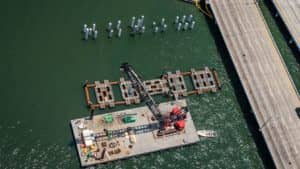
One of the barges and cranes at the site of the bridge.
Here are the updated construction highlights for the project as it stands today:
- Approximately 42% of all pilings for the bridge foundations have been driven.
- 135 of the 549 bridge footings have been constructed
- 115 of the 549 bridge columns have been completed
- 40 of the 226 bridge pier caps have been completed
- Beam placement will start in late spring, followed by deck construction this summer.
Currently, the contractors are focused on building the bridge’s foundations.
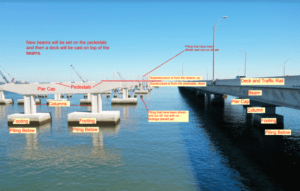
The components of the bridge.
At the site, concrete poles that travel 100 feet deep into the substrate stick out at the surface. Greg Deese, project manager with the Florida Department of Transportation, said workers will pour a cap on top of the poles to form what they call a pier. Later this spring, the team will begin to place concrete beams to connect those piers.
When completed, FDOT expects the new bridge to last about 100 years – roughly double the lifespan of the existing structure.
Deese explained that saltwater dictates much of a bridge’s lifespan, as it creates corrosion.
“In the last 50 years when the bridge was built, we learned a lot about corrosion and how concrete interacts with saltwater. We have made improvements in the materials and increased what we call our cover distance, the distance the salt has to travel through the concrete before it gets to the steel,” he said, explaining there’s also new technology to mitigate corrosion.
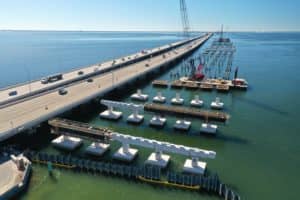
Image of the piling and footing along the existing Howard Frankland bridge.
Connecting the dots
The new bridge will also support innovative transit modes, from rail to bus rapid transit.
The plan to integrate the infrastructure for transit options comes at a time when the South Florida-based Brightline is planning an Orlando to Tampa connection for its high-speed intercity passenger train. Agencies in the region are also studying bus rapid transit (BRT) projects such as the 41-mile Regional Rapid Transit line that would connect through Pinellas, Hillsborough and Pasco counties.
“Part of the bridge can accommodate the loading from a light rail system, so if we do have a plan of connecting Hillsborough and Pinellas counties by the bridge we will be able to carry light rail without any structural retrofits,” Deese said, explaining FDOT wouldn’t have to build an entirely new structure.
“We are coordinating closely with Brightline for its system as it heads into the Tampa area [which will utilize Interstate I-4],” FDOT District 7 Secretary David Gwynn said.
Brightline is targeting a 2028 opening date for Tampa, and plans to build a station in Ybor.
Construction is expected to start in 2023 for the $1.2 billion Westshore Interchange. The project entails adding lanes and toll lanes from the northern end of the Howard Frankland Bridge through downtown Tampa. The improvement project also will reconnect roads and neighborhoods.
Meanwhile, the $600 million Gateway project, which will wrap up by 2023, will also be a major game-changer in the region. The Gateway project involves the construction of two new elevated tolled roadways that will provide direct connections between U.S. 19 and Interstate I-275 through northern Pinellas County, and the Bayside Bridge. The project is intended to relieve congestion along Roosevelt Boulevard and Ulmerton Road.
“We are also designing the express lanes from the Gateway to go into downtown St. Pete,” Gwynn said. “Once all of that gets built, we will have a dedicated expressway system that will go from downtown St. Pete up to the Howard Frankland Bridge and through the Westshore Interchange. At that point, people have the option to take the express lanes to the airport, the Veterans Expressway or downtown Tampa. You would have this express lane corridor that would also be a regional transit corridor.”


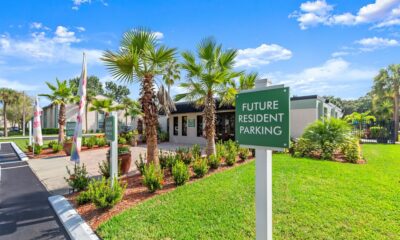





Jeffrey T Waechter
March 14, 2022at1:38 pm
Isn’t the current bridge 5 lanes to Tampa? The new bridge has 4 lanes plus “toll lanes”. Sounds like a step backwards unless your a 1%er and can afford extra $$ for tolls. And don’t tell me that the current setup is only 4 lanes – the 5th “exit lane” still moves traffic across the bay and is free of charge.
Veronica Brezina
March 14, 2022at1:57 pm
It’s eight lanes in total.
Dennis Stephens
March 12, 2022at10:49 am
Great story! Excellent reporting!